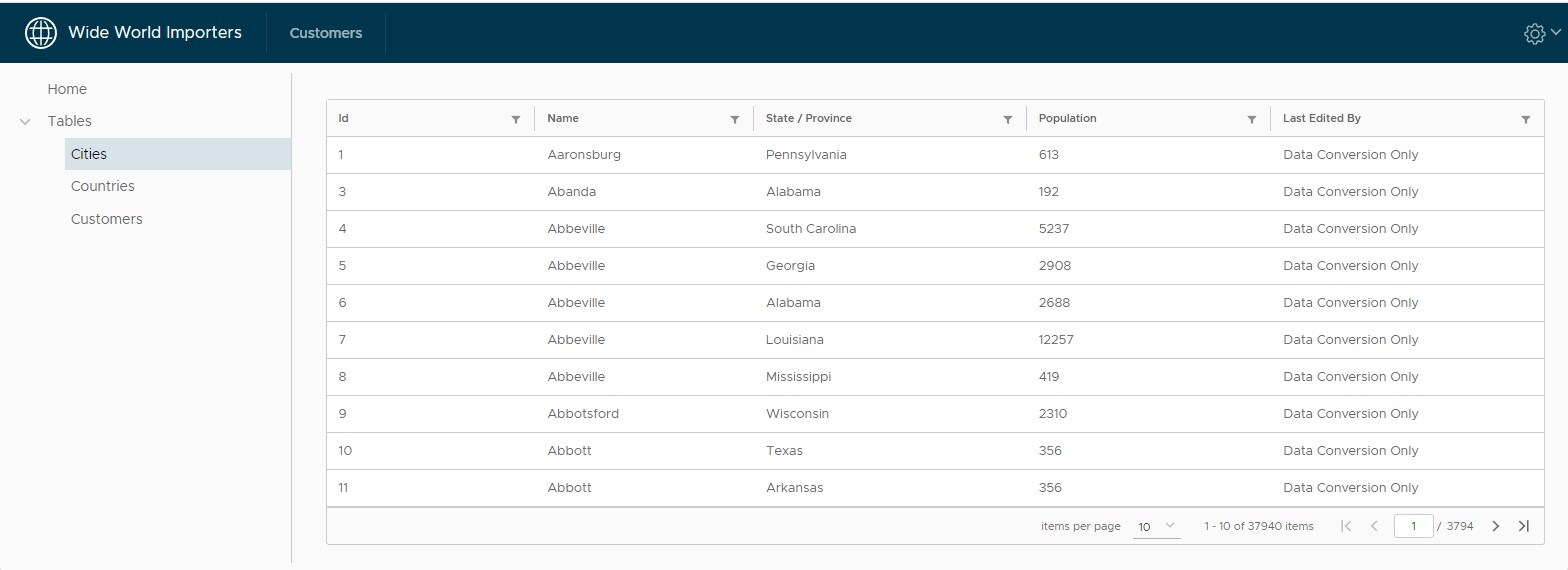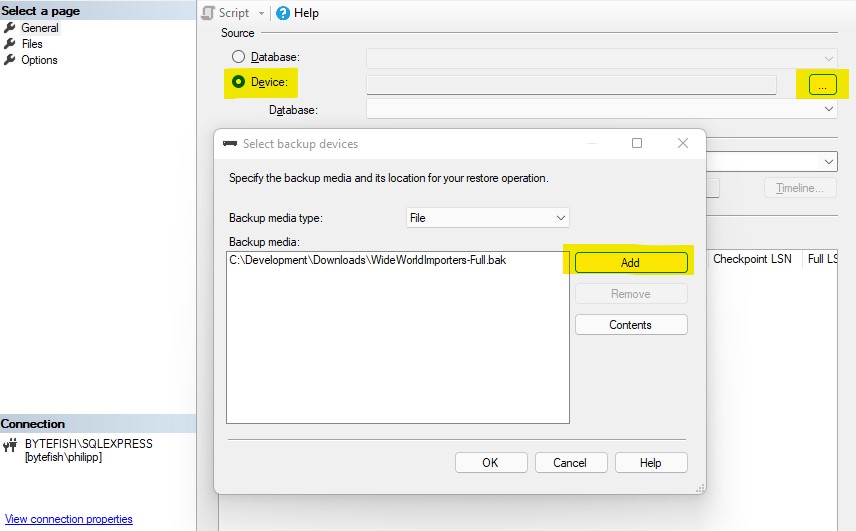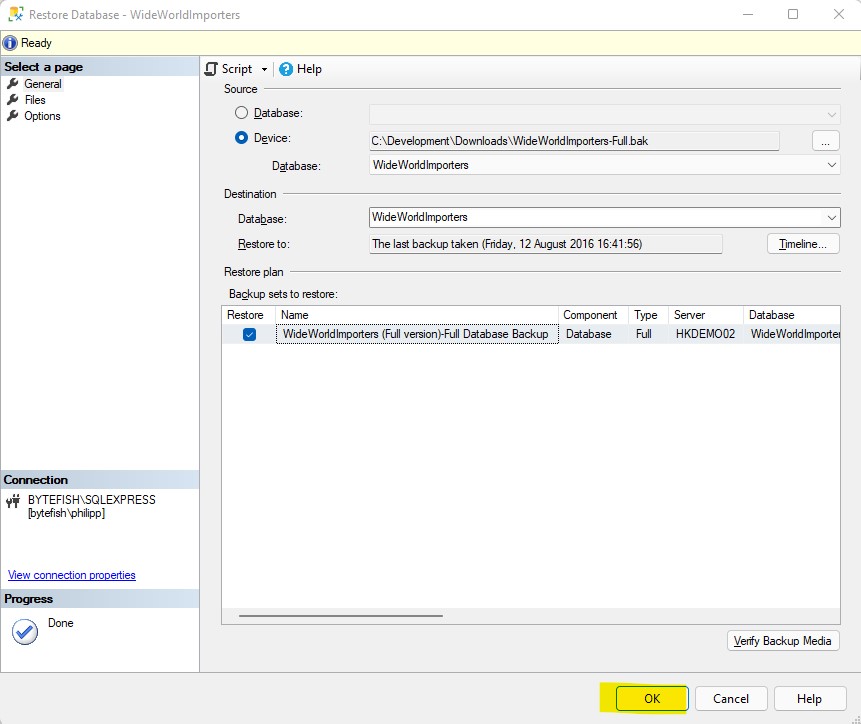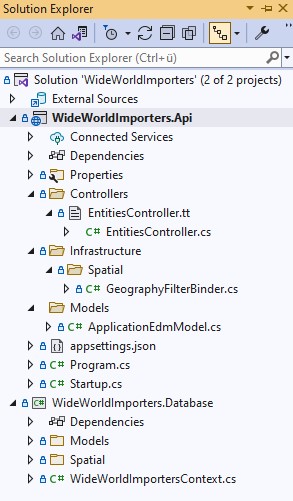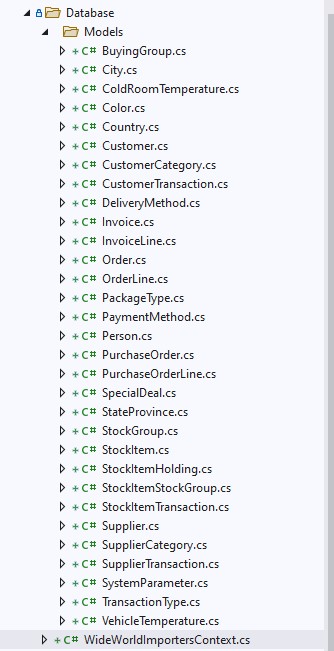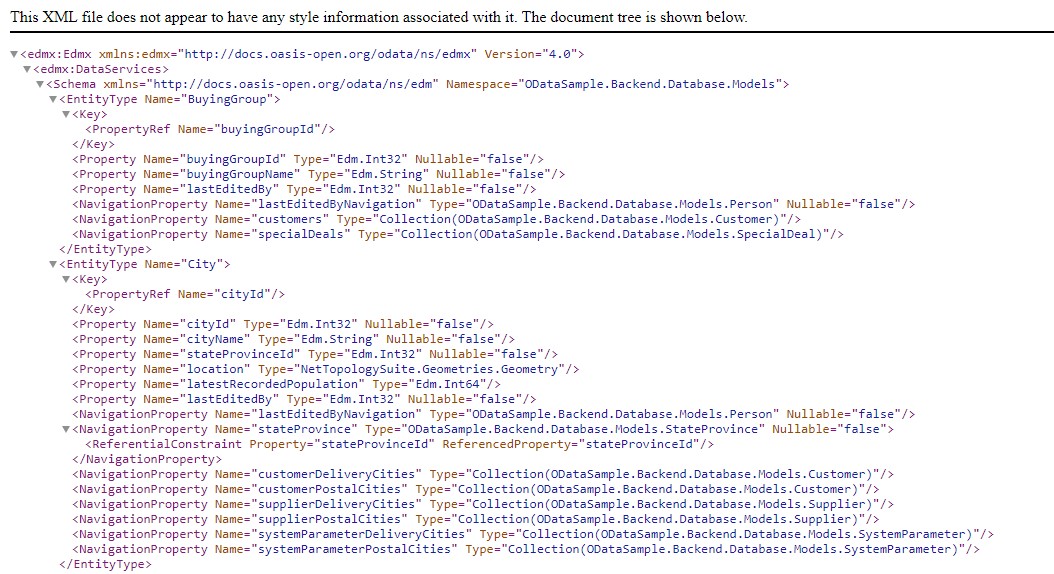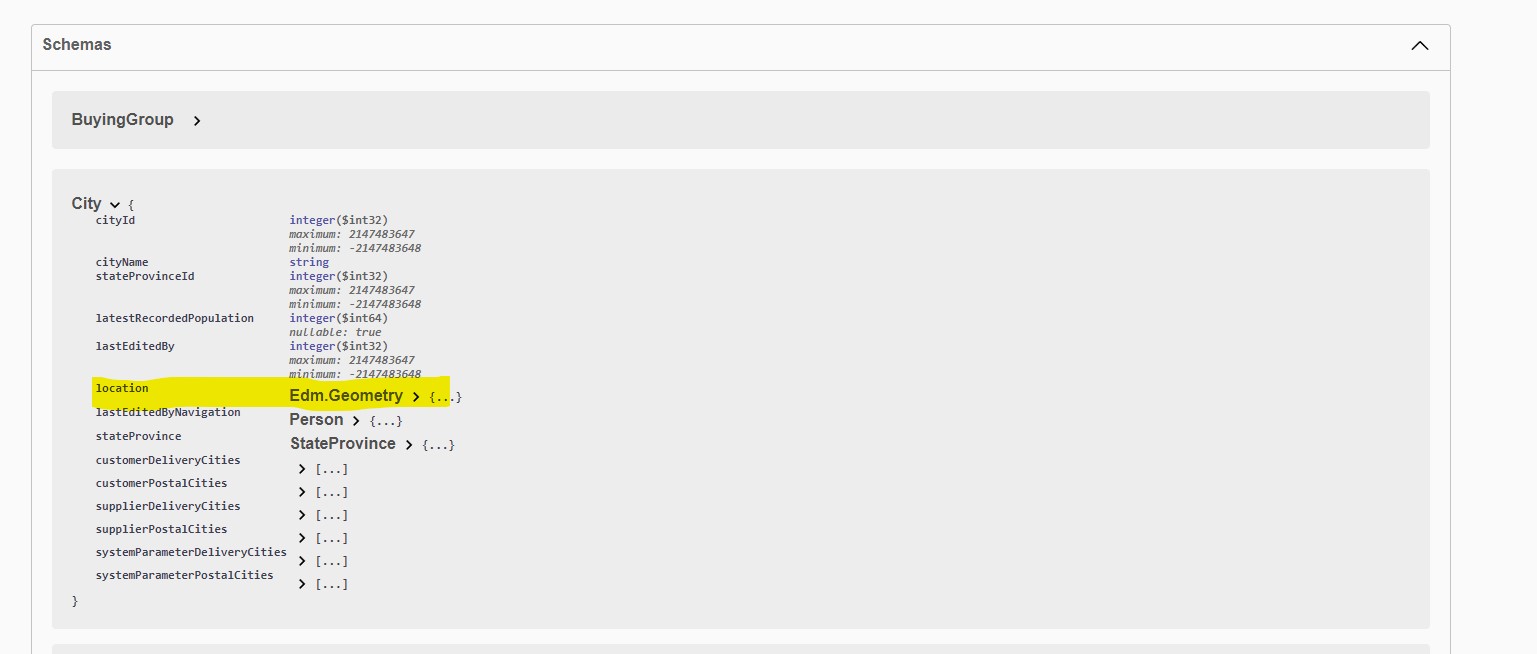In this article I will show you how to use ASP.NET Core OData and EF Core to quickly build Backends and how to use Angular to display, filter and paginate datasets. It's not complicated, but there had been quite a few pieces to the puzzle.
This article deals with the Backend with ASP.NET Core OData, the article for the Frontend is available at:
All code can be found at:
Table of contents
- Table of contents
- What we are going to build
- Wide World Importers Database
- ASP.NET Core OData Backend
- Spatial Data in ASP.NET Core OData
- Conclusion
What we are going to build
We will build a Backend and Frontend for the "Wide World Importers" database, which is a Microsoft SQL Server sample database for a fictional company:
We are building a Backend, that scaffolds the WWI database and exposes the data with Microsoft ASP.NET Core OData 8. We will learn how to extend Microsoft ASP.NET Core OData 8 for spatial types, see how to generate the OData endpoints using T4 Text Templates and provide OpenAPI 3.0 documents for Frontend code generation goodies.
The Frontend is an Angular application to query the OData endpoints. We are going to use Angular components of the Clarity Design system, because Clarity takes a Desktop-first approach and has a very nice Datagrid, that's easy to extend:
The final application will look like this:
So let's go ahead and write an application. 👍
Wide World Importers Database
It's always a very time-consuming task to build interesting datasets for articles. So I had a look at the list of Microsoft SQL Server sample databases, because... I am sure a lot of thoughts have been put into them:
What I like about the "Wide World Importers" sample database is, that it has been crafted to work well with Scaffolding. It has Stored Procedures, Views, Temporal Tables, Spatial Types... basically a lot of things to explore (and traps to fall into):
About the Database
The Microsoft documentation describes the fictionous "Wide World Importers" as ...
[...] a wholesale novelty goods importer and distributor operating from the San Francisco bay area.
As a wholesaler, WWI's customers are mostly companies who resell to individuals. WWI sells to retail customers across the United States including specialty stores, supermarkets, computing stores, tourist attraction shops, and some individuals. WWI also sells to other wholesalers via a network of agents who promote the products on WWI's behalf. While all of WWI's customers are currently based in the United States, the company is intending to push for expansion into other countries.
WWI buys goods from suppliers including novelty and toy manufacturers, and other novelty wholesalers. They stock the goods in their WWI warehouse and reorder from suppliers as needed to fulfil customer orders. They also purchase large volumes of packaging materials, and sell these in smaller quantities as a convenience for the customers.
Recently WWI started to sell a variety of edible novelties such as chilli chocolates. The company previously did not have to handle chilled items. Now, to meet food handling requirements, they must monitor the temperature in their chiller room and any of their trucks that have chiller sections.
I think it's a perfect non-trivial database to work with!
Using Docker to Restore the Database Backup
The easiest way to get started is to use Docker.
Go to the docker folder of the GitHub repository:
And run ...
docker compose up
A container will be created, that has an SQL Server 2022+ (Port 1533) and the Wide World Importers OLTP database.
Restoring the Database Backup Manually
You can also import the database manually to your SQL Server database.
We are going to work with WideWorldImporters OLTP Database which is described at:
In the Releases for the Repository you can find a full Backup (WideWorldImporters-Full.bak ):
From the GitHub Release Page we are downloading the Backup WideWorldImporters-Full.bak and import it.
We start the SQL Server Management Studio and connect to our SQLEXPRESS instance, right click on Databases and select "Restore Database ...":
On the "General" page select "Device" as the Source and select the Backup like this:
We are now ready to import the database:
The default settings will fit. Click "Ok" and wait a moment for the backup to be restored.
And... that's it!
ASP.NET Core OData Backend
Solution Overview
It's a good idea to get an high-level overview of the project first, so you get a basic idea:
The Solution consists of two projects:
WideWorldImporters.Api- A ASP.NET Core Web API project to define the OData EDM Model and provide endpoints for all entities.
WideWorldImporters.Database- A Library project, that contains the Scaffolded Model and Database Context for the Wide World Importers database.
A deeper drill-down shows what the reasoning behind the folder structure is:
WideWorldImporters.Api/Controllers- T4 Text Template to generate the ODataController
/Infrastructure/Spatial- Adds Geometric support to Microsoft ASP.NET Core OData 8.
/Models- The EDM Model for the Application.
Startup.cs- Configures the ASP.NET Core request pipeline.
WideWorldImporters.Database/ContextDbContextgenerated by the Scaffolding.
/Models- Database Models generated by the Scaffolding.
Spatial- Partial Classes to allow Spatial OData Queries for the Entity Types.
WideWorldImportContext.cs- The generated
DbContextfor the WWI Database.
- The generated
Scaffolding the Database
We'll create a separate WideWorldImporters.Database project first, so we can evolve the Database "independently" of the Api.
Installing the dotnet-ef Command Line Interface
In EF Core you are using a dotnet-ef Command Line Interface for Scaffolding. It needs to be installed first, so switch to the
Package Manager Console (View -> Other Windows -> Package Manager Console) and type:
dotnet tool install --global dotnet-ef
Installing EntityFramework Core dependencies
According to the "Entity Framework Core tools reference" documentation we also need to install Microsoft.EntityFrameworkCore.Design to use the Database-first tooling:
dotnet add package Microsoft.EntityFrameworkCore.Design
And because the database has some spatial data types, we also add the following package:
PM> dotnet add package Microsoft.EntityFrameworkCore.SqlServer.NetTopologySuite
Scaffold the Database using the dotnet-ef CLI
The best place to start is the "Reverse Engineering" documentation, which describes all the switches and parameters of the dotnet ef tooling:
We only want the tables in the Purchasing, Sales and Warehouse schema to be scaffolded, so we add the following switch:
--schema Application --schema Purchasing --schema Sales --schema Warehouse
We want the models to go into the models folderModels and assign the namespaces, so we add the following switch:
--context-dir "." --output-dir "Models" --context-namespace "WideWorldImporters.Database" --namespace "WideWorldImporters.Database.Models"
All this results in the following highly readable dotnet CLI command, which we will execute in the WideWorldImporters.Database folder:
PM> dotnet ef dbcontext scaffold "Server=localhost\SQLEXPRESS;Database=WideWorldImporters;Trusted_Connection=True;" Microsoft.EntityFrameworkCore.SqlServer --schema Application --schema Purchasing --schema Sales --schema Warehouse --context-dir "." --output-dir "Models" --context-namespace "WideWorldImporters.Database" --namespace "WideWorldImporters.Database.Models"
Build started...
Build succeeded.
To protect potentially sensitive information in your connection string, you should move it out of source code. You can avoid scaffolding the connection string by using the Name= syntax to read it from configuration - see https://go.microsoft.com/fwlink/?linkid=2131148. For more guidance on storing connection strings, see http://go.microsoft.com/fwlink/?LinkId=723263.
Our Solution now contains the WideWorldImportersContext and all model classes:
We need to register the WideWorldImportersContext in the Dependency Container of the WideWorldImporters.Api project, so we modify its Startup like this:
// ...
namespace ODataSample.Backend
{
public class Startup
{
// ...
// This method gets called by the runtime. Use this method to add services to the container.
public void ConfigureServices(IServiceCollection services)
{
// Register DbContexts:
services.AddDbContext<WideWorldImportersContext>(options =>
{
options.EnableSensitiveDataLogging();
options.UseSqlServer(@"Server=localhost\SQLEXPRESS;Database=WideWorldImporters;Trusted_Connection=True;", o => o.UseNetTopologySuite());
});
// ...
}
}
}
That's it for the Scaffolding!
Adding ASP.NET Core OData 8
What's ASP.NET Core OData? It's Microsofts implementation of the OData (Open Data Protocol) specification, which ...
[...] is an ISO/IEC approved, OASIS standard that defines a set of best practices for building and consuming REST APIs. It enables creation of REST-based services which allow resources identified using Uniform Resource Locators (URLs) and defined in a data model, to be published and edited by Web clients using simple HTTP messages.
So we start by installing the ASP.NET Core OData library into the WideWorldImporters.Api project:
PM> dotnet add package Microsoft.AspNetCore.OData
Application EDM Data Model
We define an ApplicationEdmModel class to provide the applications IEdmModel, which is used to build the
EDM Schema by ASP.NET Core OData. We will add all generated models as an EntitySet, so they can be queried:
// Licensed under the MIT license. See LICENSE file in the project root for full license information.
using Microsoft.OData.Edm;
using Microsoft.OData.ModelBuilder;
using Microsoft.Spatial;
using WideWorldImporters.Database.Models;
namespace WideWorldImporters.Api.Models
{
public static class ApplicationEdmModel
{
public static IEdmModel GetEdmModel()
{
var modelBuilder = new ODataConventionModelBuilder();
modelBuilder.EntitySet<BuyingGroup>("BuyingGroups");
modelBuilder.EntitySet<City>("Cities");
modelBuilder.EntitySet<ColdRoomTemperature>("ColdRoomTemperatures");
modelBuilder.EntitySet<Color>("Colors");
modelBuilder.EntitySet<Country>("Countries");
modelBuilder.EntitySet<Customer>("Customers");
modelBuilder.EntitySet<CustomerCategory>("CustomerCategories");
modelBuilder.EntitySet<CustomerTransaction>("CustomerTransactions");
modelBuilder.EntitySet<DeliveryMethod>("DeliveryMethods");
modelBuilder.EntitySet<Invoice>("Invoices");
modelBuilder.EntitySet<InvoiceLine>("InvoiceLines");
modelBuilder.EntitySet<Order>("Orders");
modelBuilder.EntitySet<OrderLine>("OrderLines");
modelBuilder.EntitySet<PackageType>("PackageTypes");
modelBuilder.EntitySet<PaymentMethod>("PaymentMethods");
modelBuilder.EntitySet<Person>("People");
modelBuilder.EntitySet<PurchaseOrder>("PurchaseOrders");
modelBuilder.EntitySet<PurchaseOrderLine>("PurchaseOrderLines");
modelBuilder.EntitySet<SpecialDeal>("SpecialDeals");
modelBuilder.EntitySet<StateProvince>("StateProvinces");
modelBuilder.EntitySet<StockGroup>("StockGroups");
modelBuilder.EntitySet<StockItem>("StockItems");
modelBuilder.EntitySet<StockItemHolding>("StockItemHoldings");
modelBuilder.EntitySet<StockItemStockGroup>("StockItemStockGroups");
modelBuilder.EntitySet<StockItemTransaction>("StockItemTransactions");
modelBuilder.EntitySet<Supplier>("Suppliers");
modelBuilder.EntitySet<SupplierCategory>("SupplierCategories");
modelBuilder.EntitySet<SupplierTransaction>("SupplierTransactions");
modelBuilder.EntitySet<SystemParameter>("SystemParameters");
modelBuilder.EntitySet<TransactionType>("TransactionTypes");
modelBuilder.EntitySet<VehicleTemperature>("VehicleTemperatures");
// Configure EntityTypes, that could not be mapped using Conventions. We
// could also add Attributes to the Model, but I want to avoid mixing the
// EF Core Fluent API and Attributes.
modelBuilder.EntityType<StockItemHolding>().HasKey(s => new { s.StockItemId });
// Send as Lower Camel Case Properties, so the JSON looks better:
modelBuilder.EnableLowerCamelCase();
return modelBuilder.GetEdmModel();
}
}
}
Adding OData Services to ASP.NET Core
In the Startup we can now use the IServiceCollection#AddOData() extension to add all OData dependencies
and configure the OData Routes. We are providing the IEdmModel:
// ...
namespace ODataSample.Backend
{
public class Startup
{
// ...
// This method gets called by the runtime. Use this method to add services to the container.
public void ConfigureServices(IServiceCollection services)
{
// ...
// Register ASP.NET Core Mvc:
services
// Register Web API Routes:
.AddControllers()
// Register OData Routes:
.AddOData((opt) =>
{
opt.AddRouteComponents("odata", ApplicationEdmModel.GetEdmModel())
.EnableQueryFeatures().SetMaxTop(250);
});
}
}
}
We can now start the project and navigate to the following endpoint to get the full EDMX model:
http://localhost:5000/odata/$metadata
And drums please 🥁 ...
Job done! 👍
Creating an OData-enabled Controller
The Entity sets are exposed with an ODataController in ASP.NET Core OData. I want to have a Get, GetById, Put,
Patch and Delete endpoint for every Entity set. And I am lazy, so I don't want to write it by hand, that needs to be
generated.
We can use T4 Text Templates, easily the most underrated tool in .NET development:
In the WideWorldImporters.Api project we create a new Folder Controllers and add a new Text Template named EntitiesController.tt:
<#@ output extension=".cs"#>
<#@ template language="C#" hostspecific="True" #>
<#
// We cannot reuse the ApplicationEdmModel, so let's type the EntitySet names by hand:
var entitySets = new EntitySet[]
{
new EntitySet("BuyingGroups", "BuyingGroup", "buyingGroupsId", "int"),
// ...
};
#>
//------------------------------------------------------------------------------
// <auto-generated>
// This code was generated from a template.
//
// Manual changes to this file may cause unexpected behavior in your application.
// Manual changes to this file will be overwritten if the code is regenerated.
// </auto-generated>
//------------------------------------------------------------------------------
using Microsoft.AspNetCore.Mvc;
using Microsoft.AspNetCore.OData.Deltas;
using Microsoft.AspNetCore.OData.Query;
using Microsoft.AspNetCore.OData.Routing.Controllers;
using WideWorldImporters.Api.Database;
using WideWorldImporters.Api.Database.Models;
using WideWorldImporters.Api.Services;
using Microsoft.OpenApi.OData;
using Microsoft.OpenApi.Extensions;
using Microsoft.OpenApi;
namespace WideWorldImporters.Api.Controllers
{
public partial class EntitiesController : ODataController
{
private readonly WideWorldImportersContext _context;
public EntitiesController(WideWorldImportersContext context)
{
_context = context;
}
#region Swagger Endpoint
[HttpGet("odata/$swagger")]
public IActionResult GetSwaggerDocument([FromServices] IEdmService edmService)
{
var edmModel = edmService.GetEdmModel();
// Convert to OpenApi:
var openApiSettings = new OpenApiConvertSettings
{
ServiceRoot = new("http://localhost:5000"),
PathPrefix = "odata",
EnableKeyAsSegment = true,
};
var openApiDocument = edmModel.ConvertToOpenApi(openApiSettings);
var openApiDocumentAsJson = openApiDocument.SerializeAsJson(OpenApiSpecVersion.OpenApi3_0);
return Content(openApiDocumentAsJson, "application/json");
}
#endregion Swagger Endpoint
<# foreach(var entitySet in entitySets) { #>
#region <#= entitySet.EntitySetName #>
[EnableQuery]
[HttpGet("odata/<#= entitySet.EntitySetName #>")]
public IActionResult Get<#= entitySet.EntitySetName #>()
{
return Ok(_context.<#= entitySet.EntitySetName #>);
}
// ... GetById, Post, Put, Patch, Delete left out ...
#endregion <#= entitySet.EntitySetName #>
<# } #>
}
}
<#+
public class EntitySet
{
public readonly string EntityName;
public readonly string EntityKeyName;
public readonly string EntityKeyType;
public readonly string EntitySetName;
public EntitySet (string entitySetName, string entityName, string entityKeyName, string entityKeyType)
{
EntitySetName = entitySetName;
EntityName = entityName;
EntityKeyName = entityKeyName;
EntityKeyType = entityKeyType;
}
}
#>
The generated code looks good and best of it all... it actually compiles:
//------------------------------------------------------------------------------
// <auto-generated>
// This code was generated from a template.
//
// Manual changes to this file may cause unexpected behavior in your application.
// Manual changes to this file will be overwritten if the code is regenerated.
// </auto-generated>
//------------------------------------------------------------------------------
using Microsoft.AspNetCore.Mvc;
using Microsoft.AspNetCore.OData.Deltas;
using Microsoft.AspNetCore.OData.Query;
using Microsoft.AspNetCore.OData.Routing.Controllers;
using Microsoft.OpenApi.OData;
using Microsoft.OpenApi.Extensions;
using Microsoft.OpenApi;
using WideWorldImporters.Api.Models;
using WideWorldImporters.Database;
using WideWorldImporters.Database.Models;
namespace WideWorldImporters.Api.Controllers
{
public partial class EntitiesController : ODataController
{
private readonly WideWorldImportersContext _context;
public EntitiesController(WideWorldImportersContext context)
{
_context = context;
}
#region Swagger Endpoint
[HttpGet("odata/swagger.json")]
public IActionResult GetSwaggerDocument()
{
var edmModel = ApplicationEdmModel.GetEdmModel();
// Convert to OpenApi:
var openApiSettings = new OpenApiConvertSettings
{
ServiceRoot = new("http://localhost:5000"),
PathPrefix = "odata",
EnableKeyAsSegment = true,
};
var openApiDocument = edmModel
.ConvertToOpenApi(openApiSettings)
.SerializeAsJson(OpenApiSpecVersion.OpenApi3_0);
return Content(openApiDocument, "application/json");
}
#endregion Swagger Endpoint
#region BuyingGroups
[EnableQuery]
[HttpGet("odata/BuyingGroups")]
public IActionResult GetBuyingGroups()
{
return Ok(_context.BuyingGroups);
}
[EnableQuery]
[HttpGet("odata/BuyingGroups/{buyingGroupsId:int}")]
public IActionResult GetBuyingGroups(int buyingGroupsId)
{
var entity = _context.BuyingGroups.Find(buyingGroupsId);
if (entity == null)
{
return NotFound();
}
return Ok(entity);
}
[HttpPost("odata/BuyingGroups")]
public IActionResult PostBuyingGroups([FromBody]BuyingGroup entity, CancellationToken token)
{
_context.Add(entity);
_context.SaveChanges();
return Created(entity);
}
[HttpPut("odata/BuyingGroups/{buyingGroupsId:int}")]
public IActionResult PutBuyingGroups(int buyingGroupsId, [FromBody] Delta<BuyingGroup> delta)
{
var original = _context.BuyingGroups.Find(buyingGroupsId);
if (original == null)
{
return NotFound($"Not found BuyingGroup with buyingGroupsId = {buyingGroupsId}");
}
delta.Put(original);
_context.SaveChanges();
return Updated(original);
}
[HttpPatch("odata/BuyingGroups/{buyingGroupsId:int}")]
public IActionResult PatchBuyingGroups(int buyingGroupsId, Delta<BuyingGroup > delta)
{
var original = _context.BuyingGroups.Find(buyingGroupsId);
if (original == null)
{
return NotFound($"Not found BuyingGroup with buyingGroupsId = {buyingGroupsId}");
}
delta.Patch(original);
_context.SaveChanges();
return Updated(original);
}
[HttpDelete("odata/BuyingGroups/{buyingGroupsId:int}")]
public IActionResult DeleteBuyingGroups(int buyingGroupsId)
{
var original = _context.BuyingGroups.Find(buyingGroupsId);
if (original == null)
{
return NotFound($"Not found BuyingGroup with buyingGroupsId = {buyingGroupsId}");
}
_context.BuyingGroups.Remove(original);
_context.SaveChanges();
return Ok();
}
#endregion BuyingGroups
// ...
}
}
Running OData Queries against the Wide World Importers database
Now let's start the Backend now and give it a shot, a browser is totally sufficient.
Navigating to http://localhost:5000/odata/Orders?$top=2 is going to return 2 orders:
{
"@odata.context": "http://localhost:5000/odata/$metadata#Orders",
"value": [
{
"orderId": 1,
"customerId": 832,
"salespersonPersonId": 2,
"pickedByPersonId": null,
"contactPersonId": 3032,
"backorderOrderId": 45,
"orderDate": "2013-01-01T00:00:00+01:00",
"expectedDeliveryDate": "2013-01-02T00:00:00+01:00",
"customerPurchaseOrderNumber": "12126",
"isUndersupplyBackordered": true,
"comments": null,
"deliveryInstructions": null,
"internalComments": null,
"pickingCompletedWhen": "2013-01-01T12:00:00+01:00",
"lastEditedBy": 7,
"lastEditedWhen": "2013-01-01T12:00:00+01:00"
},
{
"orderId": 2,
"customerId": 803,
"salespersonPersonId": 8,
"pickedByPersonId": null,
"contactPersonId": 3003,
"backorderOrderId": 46,
"orderDate": "2013-01-01T00:00:00+01:00",
"expectedDeliveryDate": "2013-01-02T00:00:00+01:00",
"customerPurchaseOrderNumber": "15342",
"isUndersupplyBackordered": true,
"comments": null,
"deliveryInstructions": null,
"internalComments": null,
"pickingCompletedWhen": "2013-01-01T12:00:00+01:00",
"lastEditedBy": 7,
"lastEditedWhen": "2013-01-01T12:00:00+01:00"
}
]
}
Navigating to http://localhost:5000/odata/Orders?$top=2&$expand=salespersonPerson returns 2 Orders with the Sales Person included in the response:
{
"@odata.context": "http://localhost:5000/odata/$metadata#Orders(salespersonPerson())",
"value": [
{
"orderId": 1,
"customerId": 832,
"salespersonPersonId": 2,
"pickedByPersonId": null,
"contactPersonId": 3032,
"backorderOrderId": 45,
"orderDate": "2013-01-01T00:00:00+01:00",
"expectedDeliveryDate": "2013-01-02T00:00:00+01:00",
"customerPurchaseOrderNumber": "12126",
"isUndersupplyBackordered": true,
"comments": null,
"deliveryInstructions": null,
"internalComments": null,
"pickingCompletedWhen": "2013-01-01T12:00:00+01:00",
"lastEditedBy": 7,
"lastEditedWhen": "2013-01-01T12:00:00+01:00",
"salespersonPerson": {
"personId": 2,
"fullName": "Kayla Woodcock",
"preferredName": "Kayla",
"searchName": "Kayla Kayla Woodcock",
"isPermittedToLogon": true,
"logonName": "kaylaw@wideworldimporters.com",
"isExternalLogonProvider": false,
"hashedPassword": "YW6bVYl2Ul5/FNeA666AxoWGlY3JfFBttBji4sSeNA4=",
"isSystemUser": true,
"isEmployee": true,
"isSalesperson": true,
"userPreferences": "{\"theme\":\"humanity\",\"dateFormat\":\"dd/mm/yy\",\"timeZone\": \"PST\",\"table\":{\"pagingType\":\"full\",\"pageLength\": 50},\"favoritesOnDashboard\":true}",
"phoneNumber": "(415) 555-0102",
"faxNumber": "(415) 555-0103",
"emailAddress": "kaylaw@wideworldimporters.com",
"photo": null,
"customFields": "{ \"OtherLanguages\": [\"Polish\",\"Chinese\",\"Japanese\"] ,\"HireDate\":\"2008-04-19T00:00:00\",\"Title\":\"Team Member\",\"PrimarySalesTerritory\":\"Plains\",\"CommissionRate\":\"0.98\"}",
"otherLanguages": "[\"Polish\",\"Chinese\",\"Japanese\"]",
"lastEditedBy": 1
}
},
{
"orderId": 2,
"customerId": 803,
"salespersonPersonId": 8,
"pickedByPersonId": null,
"contactPersonId": 3003,
"backorderOrderId": 46,
"orderDate": "2013-01-01T00:00:00+01:00",
"expectedDeliveryDate": "2013-01-02T00:00:00+01:00",
"customerPurchaseOrderNumber": "15342",
"isUndersupplyBackordered": true,
"comments": null,
"deliveryInstructions": null,
"internalComments": null,
"pickingCompletedWhen": "2013-01-01T12:00:00+01:00",
"lastEditedBy": 7,
"lastEditedWhen": "2013-01-01T12:00:00+01:00",
"salespersonPerson": {
"personId": 8,
"fullName": "Anthony Grosse",
"preferredName": "Anthony",
"searchName": "Anthony Anthony Grosse",
"isPermittedToLogon": true,
"logonName": "anthonyg@wideworldimporters.com",
"isExternalLogonProvider": false,
"hashedPassword": "L9i4OKPHd3jJkPRkBzqiPA7uAZdj7WqZx3RX6GkYGd4=",
"isSystemUser": true,
"isEmployee": true,
"isSalesperson": true,
"userPreferences": "{\"theme\":\"blitzer\",\"dateFormat\":\"mm/dd/yy\",\"timeZone\": \"PST\",\"table\":{\"pagingType\":\"simple_numbers\",\"pageLength\": 10},\"favoritesOnDashboard\":true}",
"phoneNumber": "(415) 555-0102",
"faxNumber": "(415) 555-0103",
"emailAddress": "anthonyg@wideworldimporters.com",
"photo": null,
"customFields": "{ \"OtherLanguages\": [\"Croatian\",\"Dutch\",\"Bokm\u00e5l\"] ,\"HireDate\":\"2010-07-23T00:00:00\",\"Title\":\"Team Member\",\"PrimarySalesTerritory\":\"Mideast\",\"CommissionRate\":\"0.11\"}",
"otherLanguages": "[\"Croatian\",\"Dutch\",\"Bokm\u00e5l\"]",
"lastEditedBy": 1
}
}
]
}
And navigating to http://localhost:5000/odata/Orders/1 returns the Order with ID 1:
{
"@odata.context": "http://localhost:5000/odata/$metadata#Orders/$entity",
"orderId": 1,
"customerId": 832,
"salespersonPersonId": 2,
"pickedByPersonId": null,
"contactPersonId": 3032,
"backorderOrderId": 45,
"orderDate": "2013-01-01T00:00:00+01:00",
"expectedDeliveryDate": "2013-01-02T00:00:00+01:00",
"customerPurchaseOrderNumber": "12126",
"isUndersupplyBackordered": true,
"comments": null,
"deliveryInstructions": null,
"internalComments": null,
"pickingCompletedWhen": "2013-01-01T12:00:00+01:00",
"lastEditedBy": 7,
"lastEditedWhen": "2013-01-01T12:00:00+01:00"
}
Great! 🙌
Spatial Data in ASP.NET Core OData
If you query some endpoints, you'll see a geometry data type in some tables... and booom!
It crashes.
What's the problem?
Entity Framework Core uses the NetTopologySuite library for mapping Geographical types, so all scaffolded models contain it. But
ASP.NET Core OData uses the Microsoft.Spatial library for Geographical types. What a bummer. If we expose the NetTopologySuite
objects in the EdmModel an unserializable hell is awaiting (most probably).
But let's not go crazy and solve it step by step!
Adding Microsoft.Spatial to the Scaffolded Data Model
It's impossible for me to add NetTopologySuite support to ASP.NET Core OData (Sorry!), and it's impossible for me to add support for
Microsoft.Spatial to Entity Framework Core (Sorry!). So we need to find a way to convert between both of them.
We start by adding the Microsoft.Spatial library to the WideWorldImporters.Database project:
dotnet add package Microsoft.Spatial
The OData EDM Model uses the Scaffolded Database model. All scaffolded classes are partial classes, that means we can weave additional
information to them at compile-time. Nice! This allows us all dirty tricks. To facilitate this, we need to live in the same assembly as
the partial classes.
See where this goes?
Extending Partial Classes with Microsoft.Spatial properties
The idea: We add Microsoft.Spatial properties prefixed with Edm... to the generated model using a partial class. OData knows how to work
with it. At the same time we tell the ODataModelBuilder to ignore the NetTopologySuite properties. On the other side, we will tell the
Entity Framework Core DbContext to please ignore the Microsoft.Spatial types.
Convert between Microsoft.Spatial and NetTopologySuite
What's left is a little conversion between both. So we need a way to convert between both the Microsoft.Spatial and NetTopologySuite
representation. So I am taking the dumbest approach possible... Geographical objects can be represented in a "Well Known Text (WKT)" format,
and every library dealing with Geographical data should support it:
// Licensed under the MIT license. See LICENSE file in the project root for full license information.
namespace WideWorldImporters.Database.Spatial
{
public class GeographyConverter
{
private static readonly Microsoft.Spatial.WellKnownTextSqlFormatter _wellKnownTextFormatter = Microsoft.Spatial.WellKnownTextSqlFormatter.Create();
public static TSpatialType? ConvertTo<TSpatialType>(NetTopologySuite.Geometries.Geometry? dbGeometry)
where TSpatialType : Microsoft.Spatial.Geography
{
if(dbGeometry == null)
{
return null;
}
// Take the simplest possible route and convert to Wkt:
var wellKnownText = dbGeometry.AsText();
// Then parse it based on the Source type:
switch (dbGeometry)
{
case NetTopologySuite.Geometries.Point _:
case NetTopologySuite.Geometries.MultiPoint _:
case NetTopologySuite.Geometries.Polygon _:
case NetTopologySuite.Geometries.MultiPolygon _:
return ConvertTo(wellKnownText);
default:
throw new ArgumentException($"Conversion for Type '{dbGeometry.GeometryType}' not supported");
};
TSpatialType ConvertTo(string wellKnownText)
{
using (var textReader = new StringReader(wellKnownText))
{
return _wellKnownTextFormatter.Read<TSpatialType>(textReader);
}
}
}
public static NetTopologySuite.Geometries.Geometry? ConvertFrom(Microsoft.Spatial.Geography? geography)
{
if(geography == null)
{
return null;
}
string wellKnownText;
using (var textWriter = new StringWriter())
{
_wellKnownTextFormatter.Write(geography, textWriter);
wellKnownText = textWriter.ToString();
}
return new NetTopologySuite.IO.WKTReader().Read(wellKnownText);
}
}
}
Adding Microsoft.Spatial Properties to the Data Model
Next we create a folder Models, where we will add additional data to the generated model classes using the partial keyword. Why
not directly edit the generated model classes? Because they have been generated and you don't want to recreate all the work, when you
are updating your database model.
We add a partial class City and add a property EdmLocation with the Microsoft.Spatial datatype. This Microsoft.Spatial
property is going to be used by ASP.NET Core OData, while the NetTopologySuite property is used to communicate with EF Core.
It's now as simple as:
// Licensed under the MIT license. See LICENSE file in the project root for full license information.
using Microsoft.Spatial;
using WideWorldImporters.Database.Spatial;
namespace WideWorldImporters.Database.Models
{
public partial class City
{
public GeographyPoint? EdmLocation
{
get
{
if(Location == null)
{
return default;
}
return GeographyConverter.ConvertTo<GeographyPoint>(Location);
}
set
{
Location = GeographyConverter.ConvertFrom(value);
}
}
}
}
Configuring the DbContext for Spatial types
We finally tell the EF Core ModelBuilder, that it should ignore all of our Microsoft.Spatial properties:
// Licensed under the MIT license. See LICENSE file in the project root for full license information.
using Microsoft.EntityFrameworkCore;
using WideWorldImporters.Database.Models;
namespace WideWorldImporters.Database
{
public partial class WideWorldImportersContext : DbContext
{
partial void OnModelCreatingPartial(ModelBuilder modelBuilder)
{
modelBuilder.Entity<City>().Ignore(x => x.EdmLocation);
modelBuilder.Entity<Country>().Ignore(x => x.EdmBorder);
modelBuilder.Entity<Customer>().Ignore(x => x.EdmDeliveryLocation);
modelBuilder.Entity<Supplier>().Ignore(x => x.EdmDeliveryLocation);
modelBuilder.Entity<StateProvince>().Ignore(x => x.EdmBorder);
modelBuilder.Entity<SystemParameter>().Ignore(x => x.EdmDeliveryLocation);
}
}
}
Configuring the EDM Model for Spatial types
Switch back to the WideWorldImporters.Api project and open the ApplicationEdmModel, that defines the IEdmModel.
We now have to do the exact opposite of the Entity Framework Core approach, by ignoring the NetTopologySuite types and
renaming our Edm... properties back into their "original" names:
// Licensed under the MIT license. See LICENSE file in the project root for full license information.
using Microsoft.OData.Edm;
using Microsoft.OData.ModelBuilder;
using Microsoft.Spatial;
using WideWorldImporters.Database.Models;
namespace WideWorldImporters.Api.Models
{
/// <summary>
/// Uses an <see cref="ODataConventionModelBuilder"/> to build an <see cref="IEdmModel" />.
/// </summary>
public static class class ApplicationEdmModel
{
/// <summary>
/// Builds a <see cref="IEdmModel" />.
/// </summary>
/// <returns>The <see cref="IEdmModel"/> for the application</returns>
public static IEdmModel GetEdmModel()
{
var modelBuilder = new ODataConventionModelBuilder();
// ...
// Build the Spatial Types:
BuildGeometryTypes(modelBuilder);
// Send as Lower Camel Case Properties, so the JSON looks better:
modelBuilder.EnableLowerCamelCase();
return modelBuilder.GetEdmModel();
}
private static void BuildGeometryTypes(ODataConventionModelBuilder modelBuilder)
{
modelBuilder.ComplexType<Geography>();
modelBuilder.EntityType<City>().Ignore(x => x.Location);
modelBuilder.EntityType<Country>().Ignore(x => x.Border);
modelBuilder.EntityType<Customer>().Ignore(x => x.DeliveryLocation);
modelBuilder.EntityType<Supplier>().Ignore(x => x.DeliveryLocation);
modelBuilder.EntityType<StateProvince>().Ignore(x => x.Border);
modelBuilder.EntityType<SystemParameter>().Ignore(x => x.DeliveryLocation);
// We will rewrite the Property Name from EdmLocation -> Location, so
// it matches fine with the EF Core Model for filtering.
modelBuilder.OnModelCreating += (builder) =>
{
foreach (StructuralTypeConfiguration typeConfiguration in builder.StructuralTypes)
{
foreach (PropertyConfiguration property in typeConfiguration.Properties)
{
// Let's not introduce magic strings and make it more safe for refactorings:
string propertyName = (typeConfiguration.Name, property.Name) switch
{
(nameof(City), nameof(City.EdmLocation)) => nameof(City.Location),
(nameof(Country), nameof(Country.EdmBorder)) => nameof(Country.Border),
(nameof(Customer), nameof(Customer.EdmDeliveryLocation)) => nameof(Customer.DeliveryLocation),
(nameof(Supplier), nameof(Supplier.EdmDeliveryLocation)) => nameof(Supplier.DeliveryLocation),
(nameof(StateProvince), nameof(StateProvince.EdmBorder)) => nameof(StateProvince.Border),
(nameof(SystemParameter), nameof(SystemParameter.EdmDeliveryLocation)) => nameof(SystemParameter.DeliveryLocation),
_ => property.Name,
};
property.Name = propertyName;
}
}
};
}
}
}
Running Spatial Queries
Start the WideWorldImporters.Api project and navigate to http://localhost:5000/swagger/index.html, et voila, the model now uses the correct OData types:
Querying for countries should now also return the Border Polygon:
{
"@odata.context": "http://localhost:5000/odata/$metadata#Countries",
"@odata.count": 190,
"value": [
{
"countryId": 1,
"countryName": "Afghanistan",
"formalName": "Islamic State of Afghanistan",
"isoAlpha3Code": "AFG",
"isoNumericCode": 4,
"countryType": "UN Member State",
"latestRecordedPopulation": 28400000,
"continent": "Asia",
"region": "Asia",
"subregion": "Southern Asia",
"lastEditedBy": 1,
"border@odata.type": "#GeographyPolygon",
"border": {
"type": "Polygon",
"coordinates": [
[
[ 74.89130859375001, 37.231640625 ],
[ 74.87539062500002, 37.241992187499996 ],
[ 74.83046875000002, 37.285937499999996 ],
[ 74.73056640625, 37.35703125 ],
[ 74.65937500000001, 37.394482421875 ],
[ 74.52421875000002, 37.382373046874996 ],
[ 74.444921875, 37.39560546875 ],
[ 74.34902343750002, 37.418749999999996 ],
[ 74.25966796875002, 37.415429687499994 ],
[ 74.20351562500002, 37.372460937499994 ],
[ 74.16708984375, 37.329443359375 ],
[ 74.077734375, 37.316210937499996 ],
[ 73.948828125, 37.283154296875 ],
[ 73.749609375, 37.231787109375 ],
[ 73.65351562500001, 37.23935546875 ],
[ 73.6275390625, 37.261572265625 ],
[ 73.64882812500002, 37.2912109375 ]
]
],
"crs": {
"type": "name",
"properties": { "name": "EPSG:4326" }
}
}
}
]
}
Custom FilterBinder for Geo distance queries
And what's all that good for?
This enables you to add the Spatial functionality, that isn't provided by ASP.NET Core OData 8 as of writing:
The article contains an example FilterBinder, that implements the OData geo.distance function:
// ...
namespace WideWorldImporters.Api.Infrastructure.Spatial.Binder
{
public class GeoDistanceFilterBinder : FilterBinder
{
internal const string GeoDistanceFunctionName = "geo.distance";
private static readonly MethodInfo distanceMethodDb = typeof(NetTopologySuite.Geometries.Geometry).GetMethod("Distance")!;
public override Expression BindSingleValueFunctionCallNode(SingleValueFunctionCallNode node, QueryBinderContext context)
{
switch (node.Name)
{
case GeoDistanceFunctionName:
return BindGeoDistance(node, context);
default:
return base.BindSingleValueFunctionCallNode(node, context);
}
}
public Expression BindGeoDistance(SingleValueFunctionCallNode node, QueryBinderContext context)
{
var bindGeoDistanceExpression = InternalBindGeoDistance(node, context);
if (bindGeoDistanceExpression == null)
{
throw new InvalidOperationException($"FilterBinder failed to bind FunctionName {GeoDistanceFunctionName}");
}
return bindGeoDistanceExpression;
}
public Expression? InternalBindGeoDistance(SingleValueFunctionCallNode node, QueryBinderContext context)
{
Expression[] arguments = BindArguments(node.Parameters, context);
string? propertyName = null;
foreach (var queryNode in node.Parameters)
{
if (queryNode != null && queryNode is SingleValuePropertyAccessNode)
{
SingleValuePropertyAccessNode svpan = (SingleValuePropertyAccessNode)queryNode;
propertyName = svpan.Property.Name;
}
}
Expression? expression = null;
if (propertyName != null)
{
GetPointExpressions(arguments, propertyName, out MemberExpression? memberExpression, out ConstantExpression? constantExpression);
if (memberExpression != null && constantExpression != null)
{
expression = Expression.Call(memberExpression, distanceMethodDb, constantExpression);
}
}
return expression;
}
private static void GetPointExpressions(Expression[] expressions, string propertyName, out MemberExpression? memberExpression, out ConstantExpression? constantExpression)
{
memberExpression = null;
constantExpression = null;
foreach (Expression expression in expressions)
{
var memberExpr = expression as MemberExpression;
if (memberExpr == null)
{
continue;
}
var constantExpr = memberExpr!.Expression as ConstantExpression;
if (constantExpr != null)
{
GeographyPoint? point = GetGeographyPointFromConstantExpression(constantExpr);
if (point != null)
{
constantExpression = Expression.Constant(CreatePoint(point.Latitude, point.Longitude));
}
}
else
{
if (memberExpr.Expression != null)
{
memberExpression = Expression.Property(memberExpr.Expression, propertyName);
}
}
}
}
private static GeographyPoint? GetGeographyPointFromConstantExpression(ConstantExpression expression)
{
GeographyPoint? point = default;
if (expression != null)
{
PropertyInfo? constantExpressionValuePropertyInfo = expression.Type.GetProperty("Property");
if (constantExpressionValuePropertyInfo != null)
{
point = constantExpressionValuePropertyInfo.GetValue(expression.Value) as GeographyPoint;
}
}
return point;
}
private static Point CreatePoint(double latitude, double longitude)
{
// 4326 is most common coordinate system used by GPS/Maps
var geometryFactory = NtsGeometryServices.Instance.CreateGeometryFactory(srid: 4326);
// see https://docs.microsoft.com/en-us/ef/core/modeling/spatial
// Longitude and Latitude
var newLocation = geometryFactory.CreatePoint(new Coordinate(longitude, latitude));
return newLocation;
}
}
}
Now register the FilterBinder by registering it in the IServiceCollection#AddOData method provided by ASP.NET Core OData, like this:
// Licensed under the MIT license. See LICENSE file in the project root for full license information.
// ...
namespace WideWorldImporters.Api
{
public class Startup
{
public Startup(IConfiguration configuration)
{
Configuration = configuration;
}
public IConfiguration Configuration { get; }
// This method gets called by the runtime. Use this method to add services to the container.
public void ConfigureServices(IServiceCollection services)
{
// ...
// Register ASP.NET Core Mvc:
services
// Register Web API Routes:
.AddControllers()
// ...
// Register OData Routes:
.AddOData((opt) =>
{
opt.AddRouteComponents("odata", ApplicationEdmModel.GetEdmModel(), svcs =>
{
svcs.AddSingleton<IFilterBinder, GeoDistanceFilterBinder>();
})
.EnableQueryFeatures().Select().Expand().OrderBy().Filter().Count();
});
}
// ...
}
}
Running Spatial Queries using the FilterBinder
Let's try!
New York should be somewhere around POINT(-73.9814311179 40.7614927583) if I am not mistaken.
So what Cities in our database, are in a 100m Radius of New York?
http://localhost:5000/odata/Cities?$select=CityName&$filter=geo.distance(Location, geography'POINT(-73.9814311179 40.7614927583)') lt 100
Ah, really? It's New York only?
{
"@odata.context": "http://localhost:5000/odata/$metadata#Cities(cityName)",
"value": [ { "cityName": "New York" } ]
}
And if we extend it to 10 kilometers?
http://localhost:5000/odata/Cities?$select=CityName&$filter=geo.distance(Location, geography'POINT(-73.9814311179 40.7614927583)') lt 10000
We get back a lot more Cities in our database and they look correct to me:
{
"@odata.context": "http://localhost:5000/odata/$metadata#Cities(cityName)",
"value": [
{ "cityName": "Cliffside Park" },
{ "cityName": "Edgewater" },
{ "cityName": "Fort Lee" },
{ "cityName": "Guttenberg" },
{ "cityName": "Hoboken" },
{ "cityName": "Jersey City" },
{ "cityName": "Manhattan" },
{ "cityName": "New York" },
{ "cityName": "North Bergen" },
{ "cityName": "Palisades Park" },
{ "cityName": "Ridgefield" },
{ "cityName": "Secaucus" },
{ "cityName": "Union City" },
{ "cityName": "Weehawken" },
{ "cityName": "West New York" }
]
}
So our geo.distance function works fine.
Conclusion
And we come to an end here!
ASP.NET Core OData was a fun experiment and I think it is a great piece of technology. The Microsoft team has
done a great job enabling OData for ASP.NET Core applications. The API design makes it possible to "easily" extend
the framework (a relative term when it comes to Expression trees).
And I hope the next article won't take another 10 months. 😓
